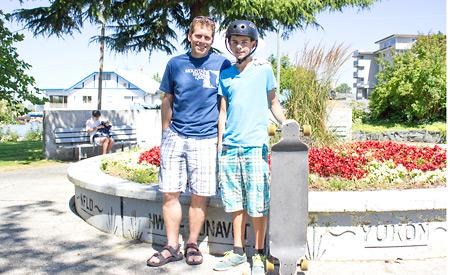Ask anyone who drives a vehicle what the scariest situation behind the wheel is, and more than likely they’ll tell you it’s when a youth on a skateboard comes darting out in front of their car in the middle of the night.
This scenario has unfortunately been occurring more often these days as longboarding has caught on in communities and cities across the country. Some cities have placed bans on the sport and drafted bylaws that foist hefty fines on boarders caught on prohibited streets. The City of Powell River is taking a slightly different tack.
It was a community consultation of sorts, except very few of those in attendance were actually of voting age. Twelve longboarding teens attended the meeting Thursday, July 25, with Mayor Dave Formosa, members of city council and a representative from the local RCMP. Their goal: talk about the future of the sport on Powell River streets.
While longboards and skateboards look roughly the same, their riding style could not be more different. Skateboards tend to be shorter and are used for aerial tricks, while longboarders ride down hills and “carve” a zigzag pattern down the road in the same way a snowboarder might go down a ski hill. They “kick out” their boards and make them slide in corners. Longboarders often take to the streets after midnight when there are fewer cars on the road. This, however, can sometimes be a recipe for tragedy.
“It’s a dangerous sport,” admitted boarder Cole Hansen, who at 20 years old spoke informally for the group. “We want to show people that we’re more than just a bunch of rowdy hoodlums.”
According to Councillor Russell Brewer, city council decided to set the meeting up after the mayor had received some complaints about youth longboarding down some of the city’s streets.
“The mayor had this idea of putting on an event and [to] use that as a way to talk to the kids,” said Brewer, who helped coordinate the afternoon meeting in city hall’s garden.
Council agreed that it would be better to sit down and chat with the longboarders and find out how they could bring the youth onside, rather than be reactive and place bans on the sport.
“Getting everyone together chatting, this is the best way,” said Brewer, whose 14-year old son Zevier longboards. “Everyone knows [closing streets to boarding] isn’t going to work.”
Council is proposing to help the boarding community set up formal longboard events on closed courses and turn the sport into something that people can rally around and be a point of pride and promote safe riding. They are looking to start small and then later bring out-of-town skaters to participate.
“It sets the tone for the younger riders when they see the older ones being serious with safety and respectful interactions with the public,” said Brewer.
Communities like Pender Harbour have established annual longboarding events that bring riders and spectators to the Sunshine Coast community for tourism.
“If we help hold a couple of events where we close the streets to cars for a couple of hours, that will go a long way in helping them moderate themselves,” said Brewer.
Hansen agreed that the boarders must take more responsibility for what they do while out riding. “I think when it comes to all that rowdiness, it falls in our hands,” he said. “It’s a small community, we need to start self-policing. If the mayor’s on your side, that’s pretty good. Organized events can help promote awareness and safety.”
Hansen described how a Vancouver skate shop started organizing safety meetings at its indoor events after riders were hit on the hills of West Vancouver’s British Properties, a mecca for longboarders.
“I’d be willing to throw down and take some time out of my day to make [younger kids’] skating a little safer,” he added.
Brewer said that council will have to add some language into the city’s bylaws to address longboarding, but he doesn’t see this as the main approach the city wants to take to address the growing number of teens jumping on longboards.
Councillors listened to the boarders talk about which streets are preferred for riding and decided to meet again to talk about what can be done on individual streets to promote safety.



